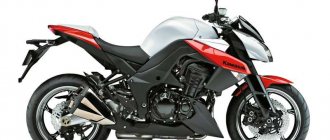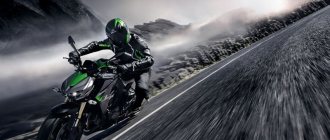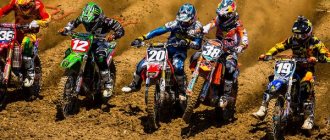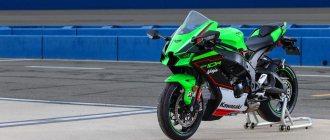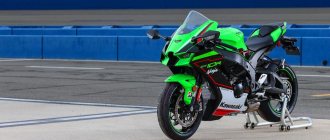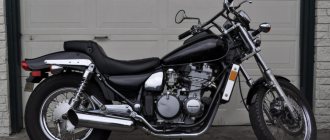Kawasaki Z900
The Kawasaki Z900 is an excellent offering from the green stable for people who like to feel the breeze and power under their butts. At first glance, this motorcycle is an ordinary “guy” with an interesting design and at a reasonable price. After using it for a long time, it turns out that this is truly a mega bike that is worth recommending, and today I will talk about it.
The Kawasaki z900 is currently in 3rd place in my personal top 5 motorcycle list, just behind the Husqvarna 701 and CBR1000RR. If I could afford to have 3 motorcycles, these would be the models in my garage. Basically, it has only one drawback, and I still regret getting it for such a short and late test. I admit, I haven't ridden it. The Russian golden autumn, which this time was just a festival of rain, prevented me from riding, but it did not kill the fan of this motorcycle in me.
Kawasaki Z900
The main disadvantage of the Kawasaki Z900?
I'll start with the shortcomings. The motorcycle is usually suitable for rainy days. And this is not due to the lack of boosters. Because it doesn't bother you at all. The problem, however, is that basically all the water from under the wheel splashes into the back. The seat on the motorcycle is narrow and short. After driving in the rain, everything was wet. Helmet, backpack, jacket. To make matters worse, there was so much water that it was even dripping from the back of the seat. This resulted in wet pants at the bottom and underwear. So if you're looking to backpack and get caught in the rain, this will probably be your last ride on the Kawasaki Z900.
I decided to take advantage of the unexpected free time during the working hours of the Kawasaki motorcycle dealership and asked for a test drive. I'll start from the end: I'm fascinated and in love. I really liked the motik. Firstly, I think this is one of the most beautiful motorcycles of our time. There is simply nothing to complain about in appearance. Well, maybe I would like a slightly smaller radiator.
Secondly, how does it drive! Oh, how he drives!
The engine is the best I've driven. Moreover, I had prejudices towards in-line fours. Like you have to turn them, but at the bottom they are rotten. So this is not true. You can stay in traffic even at 2 thousand revolutions and 5th gear. And when you unscrew the knob at these speeds, it does not begin to beat in a fit (like my Honda), but simply slowly accelerates without the slightest complaint. And already from 4 thousand it rushes with an even gain right up to eight thousand, where it still slightly picks up and flies into the red zone between 10-11.
Thanks to this bike, I understand what people are talking about when they talk about sound. Until today this area passed me by. I mean, I just didn’t understand what difference it made how a motorcycle sounded. The main thing is how it rides and how you sit on it. And it turns out that’s how it is: sound can bring pleasure. This is exactly the case. I like the way it sounds and you can always hear it, even at idle. Perhaps, with such a stock exhaust, it doesn’t even need a tachometer.
But the brakes were not surprising. Of course, they exist, but without the delight (which I had, for example, on the Tracer 900). Both the back and the front are very similar to my Honda.
There is nothing to say about the landing. I think just because it suits me. And the height/width of the steering wheel and footpegs. The wide tank is convenient for wrapping your knees around it. The seat is “two-stage”: soft at the top, but then firm. The shape of the seat, again, is the best I've ridden. The saddle height (didn't look at the technical data) seems comparable to my Honda.
I liked the box too. It’s softer than Honda’s (noticeably), so in the first moments it seems flimsy and imprecise. Neutral was always there the first time. There were no false neutrals. And what’s better than a Honda: you can pull up to a traffic light, squeeze the clutch and click through all gears from 6th to first. This trick doesn't work on my Honda.
Tidy: two beautiful chrome plated wells with clear arrows and numbers. In between is a monochrome display with additional information, in the middle of which is a large number for the gear engaged. Comfortable. In bright sunlight, the display is visible, but on the edge. Judging by YouTube, at night it all looks very beautiful and elegant.
On suspension and control. I’m afraid to give an “expert opinion from the first season,” but it seems to me like this: the suspension is stiff. Once I even flew up from the seat in a place where I drove my Honda a lot and didn’t even notice. I was very surprised. But I liked the controls (another “like” in this bike). Of course it’s better than my Honda, and I liked it even more than Tracer. At low speeds (around 50) it is as light as the Tracer, but at high speeds it feels a little more stable and precise. Zigzags are much easier on it than on my Honda. It's even difficult to explain. There’s just a lot more confidence that the motorcycle will go exactly where you want it. And here it’s worth mentioning the advantage of a naked bike that you can see the road right in front of you. There is a certain thrill in this too.
The main disadvantage of this motorcycle is the lack of wind protection. And if at +30 (as today) this is not a very big problem, then at +10 everything may be different. But I want to travel all year round and not for half an hour. And further. On the autobahn, driving more than 160 is generally uncomfortable, but sometimes I drive my Honda along the autobahn towards the mountains and quite comfortably maintain a speed of 150-180. And the second big disadvantage of a naked bike is insects at the beginning of summer. Even on my Honda, I have to wash my helmet after every ride, so what, should I wash my gear every time? This seems like a trifle, but it actually spoils the mood.
In short, I am both delighted and sad. After all, a colleague told me that there is no need to test different motorcycles, because then whatever you buy, you will regret that something else is better. But there are still 2 left on my list for a test drive: a big goose (simply because everyone is peeing at it and I need to at least try what it is) and the most likely candidate to replace my Honda – the Suzuki V-Strom 1000.
PS. At least this time it was possible to post the photos properly or as always?
Benefits of Z900
Advantages in everything else. Overall, that is the ride, engine performance, power and enjoyment of riding this bike, that despite the conditions I rode in, this bike came third on my list. If a motorcycle rides well in cold and rainy weather, it will only be better in dry and sunny weather. I really liked the thought every time that in a moment I would jump on this monster and go to town.
Kawasaki Z900
Best New 2021: Everything you need to know about the updated Kawasaki Z900 motorcycle
At the end of 2021, motorcycle manufacturer Kawasaki held a presentation of the updated Z900 bike. The new product turned out to be truly unique, thanks to the developers using improved components and equipping the motorcycle with modern technologies. And recently the new Z900 became available for purchase at branded dealerships.
The first thing worth noting is that the Kawasaki Z900 is built on a new, more durable chassis. The future owner will be able to feel the balance between an everyday bike and a real adventurer on the track. It is noteworthy that the motorcycle is more suitable for more experienced riders who value excellent handling and are not used to compromises. The developers have increased frame rigidity in key areas such as the swing arm pivot area tubes. They were already quite strong, but thanks to the improvement, the bike’s handling will increase. Increasing the rigidity resulted in the model becoming slightly heavier. The motorcycle now weighs almost 212 kg (previously 210 kg).
The developers also improved the motorcycle's optics. The headlights received a new design, the dimensions began to be equipped with LED lamps, and a separate lamp appeared in the license plate area. New suspension and tires have been made for the 2021 model year. The five-spoke wheels of the original design are equipped with 17-inch tires. The suspension was adapted to the new chassis and received a load adjustment function. The rear shock spring has also been improved.
Kawasaki is gradually increasing the list of technologies that their new models are equipped with. Thus, the Z900 is equipped with four integrated ride modes that adapt power output and traction settings to road conditions. Another innovation is the appearance of a 4.3-inch color display, which reflects the revolutions, speed and selected gear. It can also be used to navigate through selected settings.
The next improvement is the ability to customize the motorcycle through an application on a mobile phone using Bluetooth. The program will record data about the trip and its quantity, and also display the technical condition of the bike. You can configure the Z900 even while at a distance from it.
Everything else about the updated bike has been carried over from the old Kawasaki Z900 introduced in 2021. The model was equipped with a 948 cc engine and a disc brake system with four-piston calipers at the front and single-piston at the rear. The model also now comes with ABS as standard.
Driving comfort on the Z900
I'll start with the impressions that accompany a ride on this motorcycle. First of all, this is a comfortable motorcycle. The position is smoothly tilted forward, with a well-chosen steering wheel width. The seat may not be very soft, but it is not tiring. In addition, it is profiled so that our sacrum itself is where it should be when folded into a turn. And contrary to the first impression, the moto really has excellent aerodynamics. The moment you look at the speedometer, which shows 160 km/h, you do not have the impression that a rush of air is pushing away from the motorcycle - priceless! I thought the Yamaha MT-10 would be better in this regard, but there at that speed I was struggling with significant air pressure stuck to the tank. Add a narrow tank, low seat and cool legs. The MT-10 “in the knees” was slimmer and more comfortable. You may not appreciate these elements of a Kawasaki motorcycle, but they are really good.
Kawasaki Z900
Kawasaki Z900
Kawasaki Z900
Designed for Kawasaki Z900
In general, like any naked bike, this motorcycle is designed for driving around the city. This is a common “city killer”. Perhaps not quite the same as the Husqvarna 701, but city noise is the Z900's natural environment. Plus, the way it handles at higher speeds means long trips won't be an issue. Of course, it should be equipped with additional trunks and perhaps a larger window. But the Z900 tank is suitable for longer routes. He will also be good on the track. The stance and well-contoured seat make the bike corner gracefully, and the tank will be tested during a track session. Moreover, the way in which the butterfly will be donated will be appreciated by all those who love madness.
Kawasaki Z900RS - test drive
This is a retro motorcycle that we actually still remember. But will the Z900RS be as good as it seems?
The Kawasaki Z900RS has become one of the most talked about motorcycles this year. It's based on the Z900, but designed in a way you won't recognize it, with a design inspired by the 1970 Z1.
Engine.
It's a retuned 948cc inline-four from the Z900. Now it produces 111 hp. instead of 125, while the maximum torque is 98.5 Nm, but available already at 6500 rpm. instead of 7700 rpm. at Z900.
According to Kawasaki, sacrificing 14 horsepower gives you an engine that delivers well below 7,000 rpm. And this really seems to be the case; when the gas is opened, the torque increases immediately.
Meanwhile, the first gear was shortened for a better start from a standstill after a stop. Whereas the Z900's engine was already tuned to perform well at low and mid-range speeds, the Z900RS feels quite aggressive in first gear, requiring it to adjust to acceleration even after opening the throttle slightly.
Even in third gear, the engine pulls well even from 2000 rpm, giving the impression of a powerful motorcycle. The initial reaction to the throttle is a little unclear; it’s either there or not. This is especially noticeable when it is necessary to move at extremely low speeds; it turns out that the gas disappears completely or you get a sharp jerk. This problem seems to be present on all new motorcycles and is due to stricter Euro emissions regulations. But in the Z900RS it is less pronounced than in others.
The motorcycle makes it possible to exit a turn one gear higher than necessary. Throttle response smoothes output, eliminating jerkiness. And the low torque allows for efficient acceleration after straightening.
The bike also has good top-end, as you'd expect from an inline-four, and power rises linearly to a peak at 8,500 rpm and even higher until the redline at 10,000 rpm.
Kawasaki says the Z900RS is the first time they've specifically tuned the exhaust system to make it sound good. She sounds really good. But it won't make you think, “Wow, the sound was tuned specifically to sound good.” The exhaust sounds like a regular four-cylinder Kawasaki, just a little louder at low revs.
In addition to shortening first gear, sixth gear has also been lengthened to reduce vibration at high speeds. At a speed of 110 km/h the engine holds 4500 rpm. At the same time, a completely unnoticeable vibration is felt on the steering wheel.
Control.
The frame from the Z900 has been redesigned for a new role. The pipes leading to the front of the frame are positioned closer together to provide room for a different shaped fuel tank.
The subframe tubes have been strengthened and adapted to provide a more upright stance.
The result is fundamentally different from the Z900, as Kawasaki said before the trip. But it is still a steel tubular frame with an engine as a power element and five mounting points. And there's nothing wrong with that.
And it's great that the Z900RS retains the same handling characteristics as the Z900. The bike is stable, handles well in corners, is composed and precise both when entering and exiting corners on Dunlop Sportmax tyres.
But the driving position has changed. On the Z900 you had to lean a little towards the handlebars, which is typical for a super naked, but here the riding position is more upright. Which is different from the original Z1, which I was able to sit on, because Kawasaki brought the bike to the press release.
With changes to the subframe, the seat height increased from 790 mm to 835 mm. Therefore, with a height of 180 cm, it is possible to place your foot completely on the ground only with straightened legs. In fact, the bike is not tall, just not typical of a retro roadster. Thanks to the lowered seat, the height can be reduced to 800 mm.
Suspension.
The same questions have been asked many times online: “Why doesn’t the motorcycle have double rear shock absorbers?”, “Why not a classic fork?”, “Why doesn’t it have a four-muffler exhaust?”
Kawasaki's explanation that the bike would not inherit the features of the legendary Z1 was: “We wanted it to be driven.”
Norikazu Matsamura, the model's designer, said that at one point he had thoughts of a double muffler on one side, but a single one provided lighter weight and better handling.
Regarding dual shock absorbers and a classic fork, his answer was a categorical: “No.” The motorcycle must have modern components for efficient handling.
Thus, the Z900RS received a 41 mm inverted fork with adjustable preload, compression and rebound damping, and a rear horizontal gas-filled shock absorber with adjustable preload and rebound damping.
Read these specs, analyze them, and forget about them. This is a pendant you don't have to think about. Because it works great, keeping the bike balanced at all times on twisty roads.
This chassis and muscular engine make the Z900RS a very flattering motorcycle. A motorcycle that offers the ability to choose a comfortable riding style. It is equally good to ride smoothly and quickly, what other quality in a motorcycle could be better than this?
The pace of the test drive along the beautiful, winding roads picked up as morning turned into afternoon, culminating in a 45-minute photo shoot that lasted into the evening.
A trip to the city the next day revealed the true price of such a pendant. All bumps passed at speed are directly transmitted to the rider. Not to say it's uncomfortable, but the bike is made for smooth roads, not potholes.
Without the constant focus on handling as on the last day of the test, the signature seat felt a little hard after about an hour or so of riding.
Brakes.
In converting the Z900 into the Z900RS, Kawasaki has added some improved features, one of which is the front brake. While the Z900 has conventional four-piston calipers, the Z900RS features radial calipers that provide superior control.
One finger is enough to operate the brake, but if the situation on the road becomes dangerous, it is enough to increase the pressure on the lever a little to get the necessary deceleration.
As for the operation of ABS, it was activated unexpectedly, sometimes even excessively.
Equipment
The next improved element is the electronic assistants. Where the Z900 has nothing but ABS, the Z900RS boasts dual-level traction control with an off feature. Just like the Z900, the motorcycle received a slipper clutch for easier squeezing and for downshifting.
Timing is the essence of a motorcycle and that's for sure. Looking down from the bike, you'd think you were sitting on a 1973 Z1 with the orange and brown fuel tank, chrome handlebars, round mirrors and two dials with white numbers on a black background.
Even the font of these numbers is the same as on the Z1, Kawasaki says, but upon closer inspection it becomes clear that this is not entirely true. The original font is slightly taller and narrower.
The digital display located between the two dials seems like a continuity error, but gives you information about the bike, a current gear indicator, and average fuel consumption (6.1 L/100 km on the first day of aggressive riding and 5.2 L/100 km during quiet city riding).
Round mirrors are a great throwback to the past and are much preferable to the handlebar-end mounted mirrors often found on some retro motorcycles and requiring attention to be taken away from the road.
Another nice feature of the motorcycle is the chrome bar, to which you can attach luggage using straps or a net.
There is space under the seat for a disc lock (Kawasaki D-lock accessory).
There is also a tool kit under the saddle, including a screwdriver and wrench. But still, the Z1 had a more complete and necessary set of tools than this.
Kawasaki has done something that can unite two types of motorcyclists - those who love traditional motorcycles and those who love the Z1.
In other words, for those who are convinced of the popularity of retro motorcycles and for those who may be retro skeptics, but for whom the Z900RS will evoke nostalgia for the Kawasaki Z1 of their youth.
The Z900RS evokes a certain motorcycle model with its prominent tail and cast aluminum wheels reminiscent of classic spoked wheels.
More Japanese manufacturers should do something like this. Compare this bike to the XSR line, which doesn't evoke anything in anyone's memory, although Yamaha might do so if it decides to celebrate its heritage. And motorcycles like the Triumph Thruxton R and BMW R nineT are really beautiful, but they are inspired by a conventional retro motorcycle, rather than a specific model.
What I didn't like were the aluminum front fender brackets, which share the style of the R nineT and Thruxton R. It's nice, but doesn't connect with the Z1 in any way. These parts should be in chrome.
I also didn't like the fact that the orange and brown bike that most resembles the Z1 that most people will want to buy is the most expensive.
And it’s a shame that the Z900RS cafe version could not be tested together with the Z900RS, since it will appear at dealers only in March 2018.
Engine in Z900
The motor delivers power very nicely and linearly. Work characteristics based on the principle: the more you want, the more you get. The bike can move from underneath, although it tends to jerk slightly when the revs are really low. However, you don't have to redline the engine to feel satisfying acceleration. Very flexible block. At the same time, it is not boring and easily enters the gas from 1st and 2nd gears. At the same time, it is not as intrusive as the series. He won't surprise you with a sudden increase in power, he'll just give it away the more we play him. And that's enough
Kawasaki Z900
Brief history of the model
- 2017 - start of production and sales of the model.
Model
: Kawasaki Z900 + ABS (all markets).
Factory designation
: ZR900AHF + ZR900BHF.
- 2018 - appearance of modifications RS and RS Cafe.
Model
: Kawasaki Z900 + ABS;
Kawasaki Z900RS + ABS; Kawasaki Z900RS Café (all markets). Factory designation
: ZR900AJF + ZR900BJF; ZR900CJF + ZR900DJF; ZR900EJF.
- 2019 - no significant changes.
Model
: Kawasaki Z900 + ABS;
Kawasaki Z900RS + ABS; Kawasaki Z900RS Café (all markets). Factory designation
: ZR900AKF + ZR900BKF; ZR900CKF + ZR900DKF; ZR900EKF.
- 2020 - the Z900 model receives minor changes: the seat height increases to 820 mm (like the RS Cafe), LED optics and a new TFT instrument panel appear. Electronic assistants are added: KTRC (Kawasaki Traction Control), Power Mode, Smartphone connectivity.
Model
: Kawasaki Z900 + ABS;
Kawasaki Z900RS; Kawasaki Z900RS Café (all markets). Factory designation
: ZR900HLF + ZR900FLF; ZR900CLF; ZR900ELF.
- 2021 - no significant changes.
Model
: Kawasaki Z900 + ABS;
Kawasaki Z900RS; Kawasaki Z900RS Café (all markets). Factory designation
: ZR900HMFNN + ZR900FMFNN, ZR900FMFNL; ZR900CMFNN; ZR900EMFNN, ZR900EMFNL.
- 2022 - appearance of new SE modifications.
Model
: Kawasaki Z900 + ABS + SE;
Kawasaki Z900RS+SE; Kawasaki Z900RS Café (all markets). Factory designation
: ZR900HNFNN + ZR900FNFNN, ZR900FNFNL; ZR900CNFNN; ZR900ENFNN.
Brakes in Zetka
I won't say a bad word about the brakes. ABS is standard, but it works really well. No jerking is felt when turning on. His work was more accompanied by the gentle “flow” of the wheel at the limit of loss of traction. On a wet road with a little mud on a poor standard non-insulated tire, the motorcycle gradually lost speed. Not once did the wheel lock for a moment, but it was already flowing at the locking/sliding border. There were no problems on dry ground. Definitely better than the Z650. For everyday use, it is enough to use the handle with one finger, and a slight deceleration is felt.
Kawasaki Z900
Zetka pendant
The pendant is not too big so it doesn't fit
for the terrain, it's quite difficult for him. It may not look like a boat, but it feels even more uneven in the road. Sure, we have adjustability, and this bike could probably be made into a smooth daybed, but that's probably not the best idea. The motorcycle promotes fast, ambitious riding. This encourages swerving around corners. It's great to ride, so it costs a little stiffer suspension. Everything is fine in the city, so the route will not be worse. But as I already wrote: I will not ride on trails and beaten roads. Besides everything else, because this motorcycle...
Summary
Everything about the 2021 Kawasaki Z900RS is perfect, as long as you're happy with its 97 horsepower. They are enough for a quiet ride, and this motorcycle is ideal for the city. Excellent traction at medium speeds, problem-free clutch, smooth throttle response, an excellently balanced chassis steers well and holds its trajectory perfectly, an upright landing allows you to admire the surrounding landscapes or wave to cheerful girls on the sidewalk, instead of standing at a traffic light while lying on the tank. And its solid seat was much nicer than the Katana's wide, flat passenger seat. Our passenger seat experts, my wife and a colleague's girlfriend, vouched for this.
The 2021 Suzuki Katana is a sharp and precise weapon, a well-built and quite sporty motorcycle. But it's only slightly less comfortable than the Cava for everyday driving. And this everyday driving can also take place on the highway - then you will like the Katana's ergonomics even more. The original 1981 Katana was notorious for its clip-ons and shrimp-like stance, and Suzuki did their homework well here. However, fulfilling the dream of Italian designer Rodolfo Frascoli, they made one important assumption.
There isn't much space left for a gas tank under the sweeping front fairing. The tank of this model holds only 12 liters of gasoline - and with a consumption of 5.9 liters, the power reserve is treacherously small for such a motorcycle. If you twist and pile on it, the consumption can reach 7 liters per hundred.
Assistance systems in the Z900
...has no driver assistance systems other than ABS. In principle, the driver is responsible for everything that happens to the motorcycle. You don't feel any traction, no kart, and the bike doesn't have a steering damper. In other words, this is a bike for people who believe that any assistance systems are pointless and ruin the fun of riding. If you belong to this group, you will be delighted. Behind the wheel at any time you have everything this bike has to offer. If you unscrew it, you're good to go. On stock tires (by the way, the first thing I would change would be the tires), this bike flew sideways and never leaned out to begin with. If you forget, the bike will let you know by happily clicking forward.
What else
Cool watch. Despite the LCD revolution counter, we have a replacement rotating cue that operates in two modes. Or, with the increase in highlighted turns, more “hints” appear, or there is also one indicator that additionally shows us a trend of decreasing or increasing turnover. There's also a light switch replacement because the tachometer starts pulsing when it's time to change gears. For this reasonable tank and pleasant combustion. Probably even more... in other cases definitely less
We also have a well-built storage box so we can easily carry documents, keys and wallet without fear of losing them. I don’t know how to ride with a passenger, but the seat is quite small, so it can be “so-so”. Well, Kawasaki switches that do the job. The good placement, size of the buttons and the jump in their operation make them better maintainable than the Honda or Yamaha. No great equipment.
Kawasaki Z900
Kawasaki Z900
Nice motorcycle, good price
This bike is a lot of fun to drive. It's well made. And relatively cheap. Excellent value for money and I would honestly recommend it to anyone looking for a good bike for everyday riding in the city, sometimes on a country road, perhaps on some easy trail, with plenty of range, and at the same time inexpensive. This is also a noteworthy option for the lower price segment. However, probably not for beginners. A successful continuation of the series. Anyway, this bike was the basis for the old-school Z900RS, which I also had the opportunity to ride, and both bikes turned out to be very successful.
Kawasaki Z900
Kawasaki Z900
Kawasaki Z900
Kawasaki Z900
Kawasaki Z900
In conclusion, some technical characteristics.
| engine's type | 4-stroke, four-cylinder, liquid-cooled, in-line, 16-valve DOHC engine |
| capacity | 948 cm3 |
| Maximum power | 125 hp at 9500 rpm |
| Maximum torque | 98.6 Nm at 7700 rpm |
| total length | 2065 mm |
| Overall Width | 825 mm |
| Overall height | 1.065 mm |
| Saddle height | 795 mm |
| Operating weight | 210 kg |
| Fuel tank capacity | 17 liters |
Post Views: 7,875
Iconic retro styling of the 2022 Kawasaki Z 900 RS
The high-performance Kawasaki Z900 RS SE motorcycle is equipped with a new Brembo front brake system and a high-quality Öhlins rear shock absorber for a smoother ride and even greater control over the motorcycle. Just as the Z900RS features styling reminiscent of the Z1, the Z900RS SE, with its vibrant “Yellow Ball” livery, is reminiscent of another old-school Z model and is sure to catch the eye of passersby, evoking feelings of nostalgia.
CHANGES OVER STANDARD MODEL:
SOFT SUSPENSION
The SE model features an Öhlins S46 rear shock with spring preload adjuster.
Featuring an aluminum body with monotube design, a large 46mm piston, internal air and gas chambers separated by a floating piston, superior grip and handling are achieved. The official website of Kawasaki motorcycles clarifies that, unlike its counterparts, the Öhlins shock absorber, created specifically for Z models, has a double dust seal that provides excellent sealing.
Changes have also been made to the front end: the 41mm inverted front fork not only features gold-colored tubes, but also features new settings that have been tweaked to create the perfect balance between front and rear suspension throughout the entire suspension travel range. BREMBO BRAKES
At the front, a package of Brembo calipers and rotors was installed. Twin 300mm Brembo front discs are held in place by Brembo M4.32 monobloc radial-mount calipers. They are driven by a smaller diameter Nissin main brake caliper (reduced to 17.5mm from the standard model's 19.1mm) that activates braking action through stainless steel hoses, delivering stopping power and linear braking force.
ICONIC “YELLOW BALL” STYLE
The graphics
of the Kawasaki Z 900 RS SE, taken from the collection of legendary Kawasaki motorcycles, are reminiscent of the iconic “Yellow Ball” styling of the black and yellow version of the original Z1. If you buy a Kawasaki motorcycle with a fuel tank and elements painted black and yellow, it will definitely make passersby turn around. The “RS” letters of the model logo on the side caps are finished in red, further highlighted by the black aluminum side caps of the radiator, fuel injection system, and gold multi-spoke wheels.
